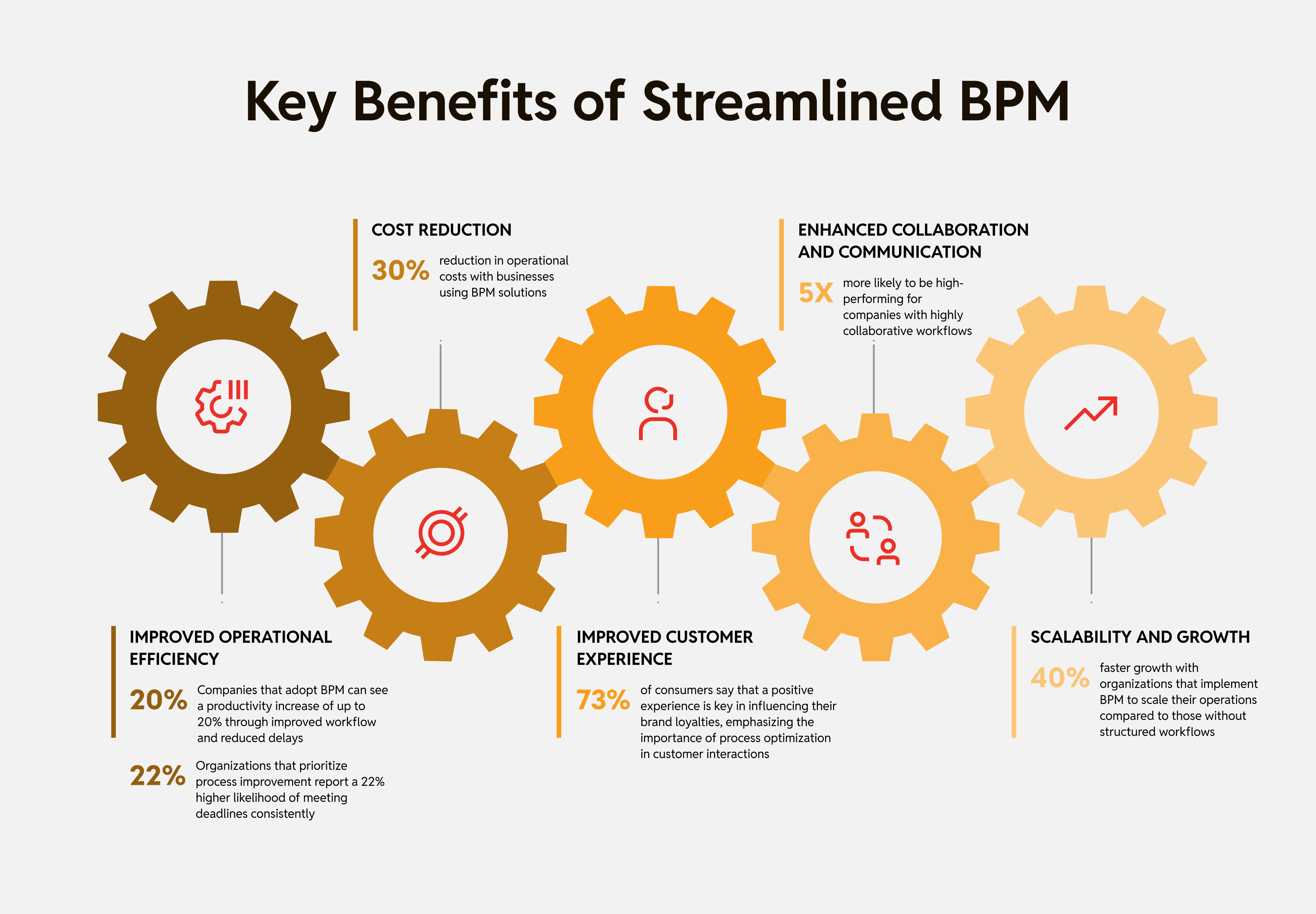In today’s business landscape, companies are constantly juggling multiple priorities—growth, innovation, efficiency, and customer satisfaction—all while navigating an increasingly complex market. However, many businesses find themselves stuck in inefficient processes that drain resources, create delays, and stifle growth. This is where streamlined Business Process Management (BPM) becomes a game-changer. By analyzing and optimizing the core processes that drive your business, BPM not only resolves operational inefficiencies but also enables a smoother path to success. In a world that rewards agility and responsiveness, BPM ensures your business can adapt, thrive, and scale with confidence.
What Is Business Process Management?
Business Process Management (BPM) refers to the systematic approach to managing and improving a company’s workflows or processes. These processes encompass everything from customer service and sales to product development and internal operations. BPM aims to make these processes more efficient, more effective, and more adaptable to change.
BPM involves analyzing current processes, identifying areas for improvement, designing optimized workflows, automating repetitive tasks, and continuously monitoring performance to ensure the processes are working as intended. A streamlined BPM approach eliminates inefficiencies, reduces errors, and provides businesses with a clear roadmap for growth and success.

Key Benefits of Streamlined BPM
1. Improved Operational Efficiency
The primary benefit of BPM is enhanced operational efficiency. By streamlining business processes, you eliminate unnecessary steps, minimize manual work, and ensure that resources are used effectively. For example, automating routine tasks can save employees hours of work every week, allowing them to focus on higher-value activities that contribute directly to business growth.
Companies that adopt BPM can see a productivity increase of up to 20% through improved workflow and reduced delays1. Additionally, organizations that prioritize process improvement report a 22% higher likelihood of meeting deadlines consistently2.
2. Cost Reduction
Inefficient processes often lead to higher costs. Whether it’s wasted resources, errors that require rework, or time spent on low-value tasks, inefficiency adds up. Streamlining business processes helps identify cost-cutting opportunities, reduce waste, and optimize resource allocation.
For example, businesses using BPM solutions have been able to reduce operational costs by as much as 30%, according to studies3.
3. Improved Customer Experience
At the heart of every business is the customer. Optimized business processes play a critical role in delivering better customer service and improving the customer experience. When your internal processes are streamlined, you can deliver faster responses, higher-quality service, and more personalized experiences.
Research shows that 73% of consumers say that a positive experience is key in influencing their brand loyalties, emphasizing the importance of process optimization in customer interactions4.
4. Enhanced Collaboration and Communication
As organizations grow, teams often face challenges in coordinating and collaborating effectively. Streamlined processes improve communication between departments, ensuring that everyone is on the same page. This improved collaboration leads to better decision-making, faster response times, and a more cohesive work environment.
Companies with highly collaborative workflows are 5 times more likely to be high-performing5.
5. Scalability and Growth
As your business expands, maintaining efficiency can become increasingly difficult. Streamlining processes ensures that your company can scale without compromising performance. Scalable processes are designed to handle increased workloads, customers, and complexities as your business grows.
Organizations that implement BPM to scale their operations experience up to 40% faster growth compared to those without structured workflows6.
Industry-Specific Examples of Streamlined BPM

1. Healthcare
In the healthcare industry, BPM can streamline patient intake, billing processes, and medical record management. By automating administrative tasks and optimizing patient flow, healthcare providers can focus on delivering better patient care while reducing costs and wait times.
Healthcare providers using BPM see an average 15% improvement in patient processing time7

2. Manufacturing
In manufacturing, BPM helps streamline the production process, reduce downtime, and enhance supply chain efficiency. By automating routine tasks such as inventory management and order processing, companies can improve production timelines and reduce operational costs.
Manufacturers adopting BPM experience a 20% reduction in production delays8.

3. Retail
In the retail industry, BPM is essential for inventory management, order fulfillment, and customer service. By optimizing these processes, retailers can ensure that they always have the right stock levels, reduce delays in order fulfillment, and provide a better shopping experience for customers.
Retailers leveraging BPM can increase on-time deliveries by up to 25%9.

4. Finance and Banking
Financial institutions can benefit from BPM by streamlining compliance, risk management, and transaction processing. Automating financial reporting and analysis reduces human error, speeds up data processing, and ensures compliance with regulatory standards. BPM also helps improve customer interactions, such as loan processing and account management, leading to higher customer satisfaction.
BPM implementation in financial services results in a 30% improvement in regulatory compliance rates10.
How to Implement Streamlined BPM
1. Assess Current Processes
Review existing workflows and identify inefficiencies, bottlenecks, and areas for improvement.
2. Set Clear Goals
Define the outcomes you want to achieve through BPM, such as increased efficiency, cost savings, or improved customer service.
3. Automate Where Possible
Implement technology to automate repetitive tasks and optimize workflows. Invest in tools that align with your business needs and goals.
4. Monitor and Continuously Improve
BPM is an ongoing process. Regularly assess your processes, gather feedback from employees and customers, and make adjustments as needed to stay ahead of the competition.

Conclusion
Streamlined business process management is a powerful strategy for unlocking your company’s full potential. By improving operational efficiency, reducing costs, enhancing customer experiences, and enabling scalability, BPM equips your business to succeed in an increasingly complex and competitive market.
As industries evolve, the need for optimized processes becomes more apparent. Whether you’re in healthcare, retail, manufacturing, or finance, streamlining your business processes will set the foundation for sustainable growth and long-term success.
Embrace BPM today, and unlock the full potential of your business.
References
- McKinsey & Company, “The Rise of BPM in Modern Business Operations”
- Deloitte, “Business Process Optimization Trends Report 2023”
- Gartner, “The Cost-Saving Potential of Process Automation in 2024”
- PWC, “Customer Experience and Brand Loyalty Statistics, 2023”
- Harvard Business Review, “The Impact of Collaboration on Organizational Performance”
- Forrester, “Scaling Operations with BPM: A Comparative Study”
- HIMSS Analytics, “BPM in Healthcare: Improving Patient Processing Times”
- Manufacturing Today, “How BPM is Reducing Delays in Manufacturing”
- Retail Dive, “BPM and On-Time Delivery in Retail: Case Studies”
- EY, “Enhancing Compliance Through Process Management in Financial Services”


